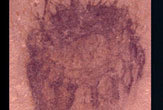The fossils are an unusual discovery because soft-bodied creatures, such as jellyfish, rarely survive in the fossil record, unlike animals with hard shells or bones.

|
| ©Unknown |
| Cambrian fossil jellyfish shows similarity to the modern jellyfish (right), Periphylla. Credit: Fossil photo by B. Lieberman. Periphylla photo by Dhugal Lindsay, Copyright JAMSTEC |
"The fossil record is biased against soft-bodied life forms such as jellyfish, because they leave little behind when they die," said study member Bruce Lieberman of the University of Kansas.
These jellyfish left their lasting imprint because they were deposited in fine sediment, rather than coarse sand. The film that the jellyfish left behind shows a clear picture, or "fossil snapshot," of the animals.
"You can see a distinct bell-shape, tentacles, muscle scars and possibly even the gonads," said study team member Paulyn Cartwright, also of KU.
The rich detail of the fossils allowed the team to compare the cnidarian (the phylum to which jellyfish, coral and sea anemones belong) fossils to modern jellyfish. The comparison confirmed that the fossils were, in fact, jellyfish and pushed the earliest known occurrence of definitive jellyfish back from 300 million to 505 million years ago.
The fossils also offer insights into the rapid species diversification that occurred during the Cambrian radiation, which began around 540 million years ago and when most animal groups start to show up in the fossil record, Lieberman said.
The complexity of these early jellyfish seems to suggest that either the complexity of modern jellyfish developed rapidly about 500 million years ago, or that jellyfish are even older and developed long before that time.



Reader Comments
to our Newsletter